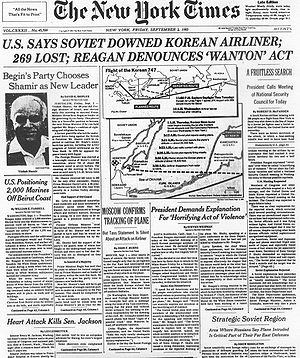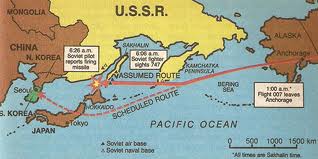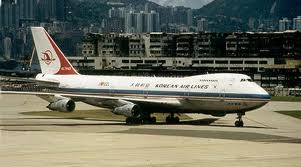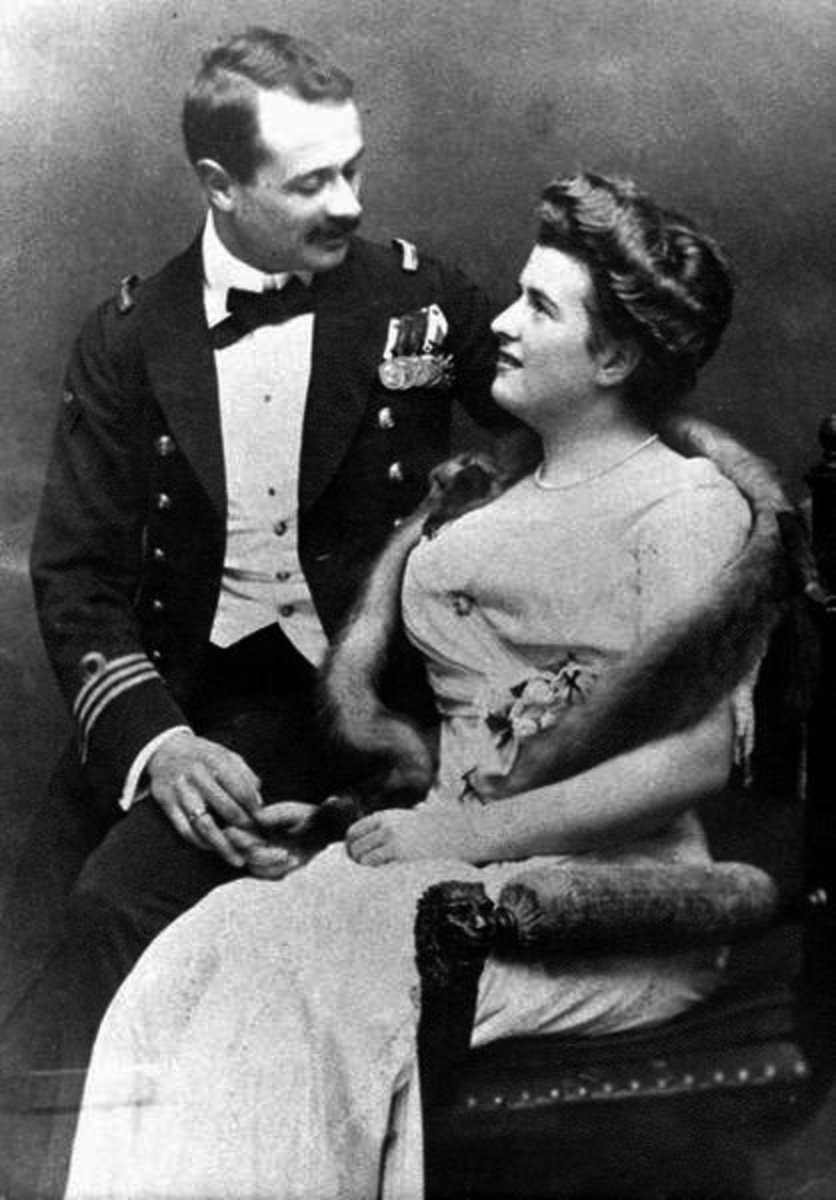- HubPages»
- Education and Science»
- History & Archaeology»
- History of the Modern Era»
- Twentieth Century History
KAL Flight 007

The loss of KAL 007 was one of the tensest moments of the Cold War with accusations flying back and forth between the United States and Soviet Union. Initially the Soviet Union denied knowledge of the incident, but later admitted to shooting the aircraft down claiming it was on a spy mission. They claimed the flight was a deliberate attempt on the part of the U.S. to test the Soviet defense systems and military preparedness. At one point the Soviets went so far as to suggest the U.S, was attempting to provoke a war. On the other hand, the U.S. accused the Soviets of obstructing search and rescue missions. The Soviets suppressed evidence sought in the investigation, most notably the flight data recorders, until eight years after the incident and after the Soviet Union had collapsed.
Flight 007 has been the subject of many differing opinions and much controversy. There have been a number of conspiracy theories regarding the flight, most of which have come about because of the suppression of evidence, unexplained details, and Cold War disinformation and propaganda. Many of these conspiracy theories are based on their author’s political point of view, but there are a few alternative interpretations that focus on evidential questions.
Flight from New York to Anchorage
KAL Flight 007 departed Gate 15 at KennedyAirport at 11:50 pm on August 30, 1983. The flight was fifteen minutes behind schedule. There were 246 passengers and twenty-three crew members on board; six of those listed as crew were actually deadheading. Twenty-two of the passengers were children under the age of twelve. Also on the flight was U.S. Congressman Lawrence McDonald who was flying to South Korea to attend ceremonies honoring the thirtieth anniversary of the U.S.-Korea Mutual Defense Treaty.
Leaving New York fifteen minutes behind KAL Flight 007, with identical destinations, was KAL Flight 015. This flight carried Senators Jesse Helms and Steven Symms as well as Representative Carroll Hubbard. They were attending the same ceremonies as McDonald.
Flight from Anchorage
At 4:00 am local time, fueled for the transoceanic flight, KAL 007 left Anchorage behind bound for Seoul. Once airborne the plane was instructed by air traffic controllers to fly directly to the Bethel navigational waypoint and then follow the northernmost transoceanic track, R-20, into Seoul. There are five North Pacific air routes known as NOPAC and each is fifty miles wide. The R-20 track passes within 17.5 miles of Soviet airspace off of the Kamchatka coast. The aircraft complied, appropriately changing its heading. However, the aircraft slowly deviated north of its intended route flying parallel to the intended track and not directly on it. Instead of flying over Bethel the aircraft actually passed twelve miles north of it. By the time the aircraft reached the next waypoint, this one 200 miles off of the Alaskan coast, it was 100 miles off track.
However, the crew gave no indication they were aware of this. They were reporting to air traffic control they were on track and flying over a sequence of navigational waypoints on their way to Seoul. The longer the flight progressed the greater the divergence was becoming. Simulation and flight data recorder analysis determined that this deviation was probably caused by the aircraft’s autopilot and undetected by the crew. There is no indication that either civilian or military air traffic controllers were aware of the flight’s deviation in real-time; therefore, they were unable to warn the flight crew. KAL 007 would fly in this heading for the next five and a half hours. KAL 007 was flying toward Siberia.

The Loss of KAL 007
August 31/September 1 was the worst possible night for KAL 007 to stray into Soviet airspace for a number of reasons. It was a few hours before the Soviets were set to test fire an SS-25, a mobile ICBM that was illegal according to SALT II agreements. The missile would be launched from northwest Russia and targeted to land on the Kamchatka Peninsula. Kamchatka was also home to several Soviet naval and air bases that were on alert for several reasons: 1) Cold War tensions at the time had escalated to a level approaching that of the Cuban Missile Crisis; 2) the Soviets were openly fearful President Reagan was planning a first strike nuclear attack; and, 3) U.S. planes had repeatedly violated Soviet airspace resulting in the dismissal or reprimanding of Soviet military officials who had been unable to shoot them down. Finally, there was a U.S. Air Force reconnaissance plane (the military version of the civilian Boeing 707) in the area keeping tabs on the upcoming Soviet missile launch.
An indication of how unaware the KAL crew was of everything that was unfolding is the casual cockpit banter at a time when there should have been great tension. An example is that at the same time a Soviet fighter is pulling in behind and locking onto the KAL they are talking about the location of the airport currency exchange.
When the flight first entered Soviet airspace fighters were scrambled and fired several bursts in front of the plane’s nose. The Soviet Premier, Yuri Andropov, maintained KAL 007 had been contacted by radio and that rounds of tracers had been fired in front of the plane. Soviet Top Secret Memos released by Boris Yeltsin in 1992 contradicted this indicating there were no tracer rounds in the bursts fired in front of KAL. When the flight recorders were examined there was no evidence of any radio contact between KAL and the Soviet fighters. Once again, the crew of KAL was totally unaware. However, KAL 007 flew over Kamchatka and left Soviet airspace heading toward Sakhalin Island.
When the Soviet military control center picked up the flight they designated the approaching blip as a military target, most likely on an intrusion mission. This identification totally changed the rules of engagement. Two fighters were scrambled and they were given direct orders that the plane was to be destroyed if it violated Soviet airspace.
As KAL 007 cruised along at 33,000 feet the Soviet fighter pulled in about four miles behind them. As the plane flew over Sakhalin Island the Soviet fighter was ordered to flash its lights and fire a burst up the side of the 747. Once again, lacking tracer rounds the crew of the KAL saw nothing and the Soviet fighter did not have enough of a visual to think it was anything but military aircraft. Tapes released years later indicate there was a lot of back and forth between the military command and the Soviet fighter. They were very concerned the plane was going to evade them for the second time that night. KAL 007 was over the Sea of Japan and heading out of Soviet airspace again.
Two air-to-air missiles from a Soviet fighter were fired at KAL 007 sending it into a twelve minute spiral into the Sea of Japan near Moneron Island. Analysis of the flight data recorder and the cockpit voice recorder indicate the 747 suffered the following damage:
- Hydraulics: The plane had four redundant hydraulic systems of which one, two and three were either damaged or destroyed. There is no evidence of damage to system four.
- Left wing: The Soviet pilot stated that one of the missiles took off half of the left wing. Flight data indicators are that the left wing had to be intact for the maneuvers that were made by the plane and that the pilot is incorrect.
- Tail section: The crossover cable connecting the left inboard elevator to the right elevator was either severed or unraveled.
- Fuselage: Shrapnel from the missile punctured the fuselage and caused rapid decompression of the cabin. Based on sounds picked up in the cockpit recorders investigators were able to determine that the total size of the ruptures was 1.75 square feet.
Although it had been struck by two missiles KAL 007 still had flight capability. Evidence of this is the following:
- There was sufficient oxygen for crew alertness; they were speaking through microphones with oxygen masks.
- The co-pilot reported twice to the captain that the engines were operating normally.
- The electrical system was operative; otherwise the radios would have not worked.
- As the plane was in its downward phase the pilot was able to decrease his speed. Had he not had some semblance of control the plane would have struck the water 2 to 2 1/2 minutes after detonation rather than over 12 minutes later.
- The plane was able to regain its pre-hit altitude almost exactly.
- The plane was able to regain its pre-hit rate of forward acceleration.
- The pilot was able to bring the nose of the 747 to the plane’s exact level of flight.
- For over four minutes the plane maintained a level flight at 5,000 feet.
- Material evidence suggests passengers had enough time to prepare for emergency water ditching.
After dropping to 5,000 feet and maintaining that altitude for over four minutes KAL 007 began to slowly spiral downward. The plane dropped off radar at 1, 000 feet.
Search and Rescue/Salvage
Immediately after the incident South Korea, owner of the aircraft, designated the United States and Japan as search and salvage agents. In effect that made it illegal for the Soviet Union to salvage the aircraft, providing it was found outside of Soviet territory. If they did so, the U.S. would be legally entitled to use force to prevent them from salvaging any part of the plane. The U.S. conducted the most massive and thorough sea search undertaken by the U.S. Navy since the search for the hydrogen bomb lost off of the coast of Spain. The search was interfered with every step of the way by the Soviets in violation of the 1972 Incident at Sea Agreement.
No human remains were ever found on the surface of the water, the Soviets did hand over items of clothing and shoes. Combined with footwear recovered by the Japanese there was a total of 213 pairs of various types of shoes recovered. These shoes comprise almost 74% of the shoes the passengers and crew would have been wearing. The shoes raise an important question: How did they get off of the feet? There are only two scenarios: 1) they were removed by the Soviets (and Japanese) from the bodies; or, 2) the passengers and crew removed them in preparation for the plane going down. Seventy-four percent of the shoes worn by the passengers were found, yet no bodies were recovered. Eight days after the incident some body parts washed up on the shores of Japan though none were identifiable. Also washing up were artifacts from the plane and passenger’s luggage.
In 1991 the Soviets released information regarding the findings of divers off the coast of Moneron Island in 571 feet of water. Following three days of searching the Soviets had located the wreckage. Since nothing had been found on the surface the divers had expected to find the plane relatively intact. What they discovered was that the wreckage was in small pieces and there were no bodies.
Conspiracy Theories
Due to the circumstances surrounding the flight, the shroud of secrecy the Soviet Union put in place regarding their role, and the simple fact there has never been a ditching of a commercial airliner at sea with total loss of life, the KAL Flight 007 incident is rife with conspiracy theories.
- Spy plane theory: KAL 007 was used as bait by the U.S. to test Soviet defenses. The assumption by the U.S. was that the civilian plane would be released from any forced landing based on the crew simply being lost. The U.S. reconnaissance plane was in the area to monitor the Soviet response.
- Assassination theory: Congressman McDonald had recently been made president of the John Birch Society, an organization that was fervently anti-Communist. The Soviets knew he was on the plane and decided to silence him. What is unexplained by the theory is that fifteen minutes behind McDonald on another plane were Helms, Symms and Hubbard. All anti-Communist and all attending the same ceremony in Seoul.
- Fuel theory: The flight deviated from the normal route to save fuel. This theory was actually considered by several law firms in the civil trial but was rejected due to the inherent dangers and lack of personal motivation for the pilots
- Captain’s error theory: This theory was put forth by the captain of the trailing KAL flight, a personal friend of the Flight 007 captain. He believes it possible the coordinates for the flight were entered improperly into the plane’s Internal Navigation System. The captain did not realize this until in flight and decided to fly by Magnetic Heading rather than dump fuel, return to Anchorage and face discipline and humiliation.
- Intentional flight deviation theory: As the flight passed through the Cairn Mt. sector they were already 6.5 miles off course in a 7.5 mile envelope. If Anchorage Air Traffic Control had made them aware of this they could have easily corrected course. Anchorage Air Traffic Control marked the position of every flight that day except for KAL Flights 007 and 015.
- Passenger survival and abduction theory: There has been so much deception and outright lying that when coupled with the known facts it is possible to imagine passengers surviving the shoot-down. Senator Jesse Helms thought the possibility to be realistic enough to write a letter to Boris Yeltsin in December 1991 asking about the fate of the passengers, what had happened with their bodies, and a list of any survivors being held by the Soviets.
Aftermath
Obviously the facts of what happened to KAL 007 will never be known, at least by the public. The rhetoric used by President Reagan was damning as he stepped up his confrontational policy for dealing with the Soviet Union but, in actuality, it wasn't long before the Sate Department was saying they hoped the incident would not hamper the improvement of relations between the U.S. and the Soviets. The incident was one of the last sparks of the Cold War before the Soviet Union fell. However, there were two main results of KAL Flight 007: 1) The Reagan Administration was able to get NATO support for the deployment of Cruise and Pershing II missiles in West Germany placing them a short six to ten minute flight from Moscow; and, 2) Reagan authorized civilian use of the military’s Global Positioning System. The GPS is not only used in your car but is used extensively in civilian air travel.








